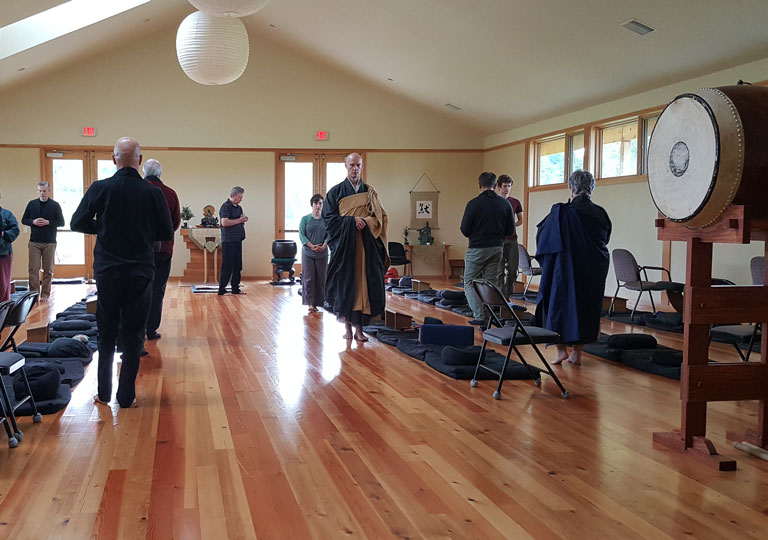Sesshins (Zen meditation retreats held in silence and seclusion), are offered about once a month at the Rochester Zen Center, and vary in length from two to seven days. About ten hours of formal zazen is done each day, and more hours of informal zazen are encouraged. Dokusan is offered three times a day. As sesshins are rigorous, demanding a great deal of the sitter, it is advisable to be sitting regularly at home (and at a Center if possible) before applying to sesshin. Anyone who has been to an introductory workshop at the Rochester Zen Center or an affiliate may apply. It is also generally advisable for beginners to start with a 2- or 4-day sesshin.
A sesshin (接心, or also 摂心/攝心 literally 'touching the heart-mind') is a period of intensive meditation (zazen) in a Zen monastery. While the daily routine in the monastery requires the monks to meditate several hours a day, during a sesshin they devote themselves almost exclusively to zazen practice. Sesshin is a week long silent meditation retreat. In sesshin we practice the settling of distracted mind This progression into stillness is developed by maintaining silence, refraining from media use and engaging in work practice, formal meals and, most importantly, zazen meditation. How I met the Dalai Lama. Dezember 6, 2019 / 0 Kommentare /. In Meditation, Personal, WIE vor WAS /. Von Karl-Ludwig Leiter. In the early 1980s, I once met the Dalai Lama at a book fair in Frankfurt am Main, Germany. More specifically, I almost literally ran into him. It was just before the book fair ended and I was hurrying out of Hall 6 to.
A sesshin is a type of Zen meditation retreat, typically held at or sponsored by a Zen monastery. Retreats can last anywhere from a day to a full week, and focus on intense, inward-looking reflection. Sesshins are by nature silent retreats, which means that there is no talking allowed amongst participants. In a traditional sesshin, attendees are barred from so much as looking at each other. A primary goal is to deeply connect with the inner self through meditation. While retreats are often widely attended, each person present is instructed to define his universe only around himself.

The word sesshin is a merging of two Japanese words: setsu, which can be translated as touching, receiving, or conveying and shin, which means mind. Sesshin is most commonly translated as “to touch the mind.” An individual’s ability to “touch” his own mind, and in so doing awaken his consciousness, is precisely the mission of this kind of meditation.
Days are spent mostly in quiet reflection. The goal is not to ponder issues or problems, but rather to come to a greater understanding and mindfulness of one’s self and the depths of one’s mind. Activities sometimes include reflective chanting, but more often than not focus on sitting still, breathing deeply, and voiding all thoughts completely.

Retreats are run by Zen masters, frequently monks. These masters often give talks or lessons in the afternoons that are followed by personal reflection and meditation. Sesshin reflection typically involves sitting cross-legged on a bamboo mat in a shared meditation room, or participating in a walking meditation along one of the pastoral trails surrounding the monastery. Meals are prepared by the monastery’s tenzo, or chef, and are shared silently, but communally.
Other typical sesshin activities include sunrise breathing exercises; reflective chores, like cleaning; and one-on-one interviews with a Zen master. The interviews are typically the only time that retreat participants engage in conversation. They are designed to help participants deepen their knowledge of Zen, and are a time for guided personal exploration more than they are for questions and answers.
Most of the time, sesshin meditation is designed as a means of deepening one’s Zen practice, not as a way of learning Zen or gaining exposure to the meditative art. It is not uncommon for sesshin organizers to go so far as to discourage newcomers from attending more than a day of two of the retreat. Beginners are often encouraged to choose day-long introductory retreats, or to attend weekend-long meditations before building up to a full week away. For many, a week of meditation is an intense experience, and is one that should be prepared for slowly over time.

Sesshin Definition
5,441 Followers, 1,208 Following, 377 Posts - See Instagram photos and videos from Sesshin (@sesshincosmetics). Sesshin is a period of intensive meditation held at Dharma Field six times a year from 2 to 5 days long.
Rochester Zen Center Sesshin
Some Zen masters use sesshin as a means of building up to larger meditation goals. For instance, in order to participate in ango — a three-month period of meditation practice and intentional living — a person usually must have attended a number of sesshin retreats, and be deemed ready by a member of the sponsoring monastery. Others simply attend retreats time and time again in order to grow stronger in their spiritual practices, and to experience deeper personal awareness.
